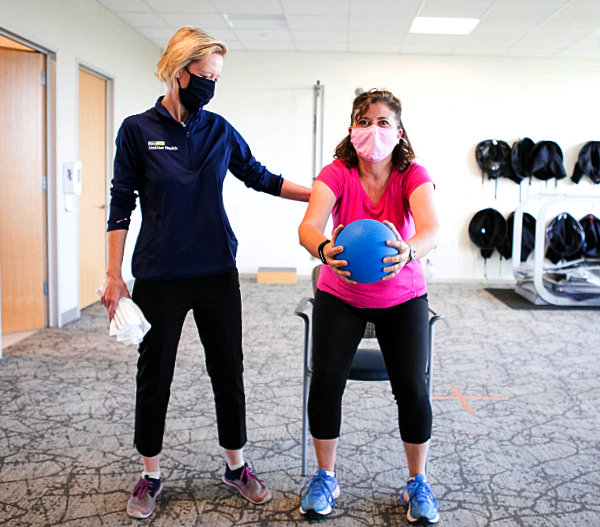States are preparing to remove millions of people from Medicaid as protections put in place early in the covid-19 pandemic expire.
The upheaval, which begins in April, will put millions of low-income Americans at risk of losing health coverage, threatening their access to care and potentially exposing them to large medical bills.
It will also put pressure on the finances of hospitals, doctors, and others relying on payments from Medicaid, a state-federal program that covers lower-income people and people with disabilities.

Almost three years ago, as covid sent the economy into free fall, the federal government agreed to send billions of dollars in extra Medicaid funding to states on the condition that they stop dropping people from their rolls.
But legislation enacted in December will be phasing out that money over the next year and calls for states to resume cutting off from Medicaid people who no longer qualify.
Now, states face steep challenges: making sure they don’t disenroll people who are still entitled to Medicaid and connecting the rest to other sources of coverage.
Even before the pandemic, states struggled to stay in contact with Medicaid recipients, who in some cases lack a stable address or internet service, do not speak English, or don’t prioritize health insurance over more pressing needs.
“We have no illusion that this will be beautiful or graceful, but we will be doing everything we can not to lose anyone in the process,” Dana Hittle, Oregon’s interim Medicaid director, said of the so-called Medicaid unwinding.
With the rate of uninsured Americans at an all-time low, 8%, the course reversal will be painful.
The Biden administration has predicted that 15 million people — 17% of enrollees — will lose coverage through Medicaid or CHIP, the closely related Children’s Health Insurance Program, as the programs return to normal operations. While many of the 15 million will fall off because they no longer qualify, nearly half will be dropped for procedural reasons, such as failing to respond to requests for updated personal information, a federal report said.
Certain states may be hit particularly hard: Nevada’s enrollment in Medicaid and CHIP has risen 47% since February 2020. Many signed up toward the start of the pandemic, when the state’s unemployment rate spiked to nearly 30%.
Ordinarily, people move in and out of Medicaid all the time. States, which have significant flexibility in how they run their Medicaid programs, typically experience significant “churn” as people’s incomes change and they gain or lose eligibility.
The unwinding will play out over more than a year.
We acknowledge that this is going to be a bumpy road
People who lose Medicaid coverage — in the more than 30 states covered by the federal marketplace — will have until July 31, 2024, to sign up for ACA coverage, CMS announced on Jan. 27. It’s unclear whether the state-based marketplaces will offer the same extended open-enrollment period.
Even states that are taking far-reaching action to make sure people don’t end up uninsured worry the transition will be rough.
In California alone, the state government forecasts that at least 2 million people out of 15 million in the program today will lose Medicaid coverage because of loss of eligibility or failure to reenroll.
“We acknowledge that this is going to be a bumpy road,” California Health and Human Services Secretary Mark Ghaly said. “We’re doing all we can to be prepared.”
In an all-hands-on-deck effort, states are enlisting Medicaid health plans, doctors, hospitals, state insurance marketplaces, and an assortment of nonprofit groups, including schools and churches, to reach out to people at risk of losing coverage.
States will also use social media, television, radio, and billboards, as well as websites and mobile phone apps, to connect with enrollees. That’s in addition to letters and emails.
Nevada has developed a mobile app to communicate with members, but only 15,000 of its 900,000 Medicaid enrollees have signed up so far.
“[T]he transient nature of Nevada’s population means that maintaining proper contact information has been difficult,” a state report said in November. At least 1 in 4 letters sent to enrollees were returned on account of a wrong address.
The law that allows states to begin disenrolling ineligible Medicaid recipients on April 1 bars states from disenrolling anyone because mail was returned as undeliverable until the state has made a “good faith effort” to contact the person at least one other way, such as by phone or email.
To further reduce disruption, the law requires states to cover children in Medicaid and CHIP for 12 months regardless of changes in circumstances, but that provision doesn’t take effect for almost a year.
States will give Medicaid recipients at least 60 days to respond to requests for information before dropping them, said Jack Rollins, director of federal policy at the National Association of Medicaid Directors.
States will use government databases such as those from the IRS and Social Security Administration to check enrollees’ income eligibility so they can renew some people’s coverage automatically without having to contact them. But some states aren’t taking full advantage of the databases.
States have until February to submit their unwinding plans to the federal Centers for Medicare & Medicaid Services, which will monitor the process.
We want to make it easier to say yes to coverage
But it is already clear that some states are doing much more than others to keep people insured.
Oregon plans to allow children to stay on Medicaid until age 6 and allow everyone else up to two years of eligibility regardless of changes in income and without having to reapply. No other state provides more than one year of guaranteed eligibility.
Oregon is also creating a subsidized health plan that would cover anyone who no longer qualifies for Medicaid but has an annual income below 200% of the federal poverty level, which amounts to about $29,000 for an individual, state officials said. The program will have benefits similar to Medicaid’s at little or no cost to enrollees.
Rhode Island will automatically move people who are no longer eligible for Medicaid — and with annual incomes below 200% of the poverty rate — into an Affordable Care Act plan and pay their first two months of premiums. State officials hope the shift will be seamless for many enrollees because they’ll be moving between health plans run by the same company.
California will move some people to a subsidized private plan on the state’s marketplace, Covered California. Enrollees will have to agree and pay a premium if they don’t qualify for a free plan. However, the premium could be as low as $10 a month, said Jessica Altman, executive director of Covered California. (Altman’s father, Drew Altman, is president and CEO of KFF. KHN is an editorially independent program of KFF.)
“We want to make it easier to say yes to coverage,” Altman said.
But experts worry about what will become of Florida Medicaid enrollees.
Florida doesn’t have its own ACA marketplace. As in most states, its residents use the federal exchange to shop for ACA plans. As a result, the handoff of people from Medicaid to marketplace may not be as efficient as it would be if it involved two state agencies that regularly work together, said Jodi Ray, director of Florida Covering Kids and Families, a nonprofit that helps people find coverage.
Another concern for advocates is that Florida makes less use of government databases than other states to check enrollees’ incomes. “We make everyone jump through hoops to get reenrolled instead of utilizing all the acceptable data,” Ray said.
Florida typically takes weeks to process Medicaid applications, while some states do it in a day, she said.
Florida’s unwinding plan illustrates the difficulty of reaching enrollees. The plan said that, since 2020, the state has identified 850,000 cases in which Medicaid recipients did not respond to requests for information.
Florida Medicaid officials did not return calls for comment.
While state officials struggle to manage the unwinding, health care providers are bracing for the fallout.
Dennis Sulser, chief executive of Billings, Montana-based Youth Dynamics, which provides mental health services to many children on Medicaid, expects some will lose coverage because they get lost in the process.
That could leave patients unable to pay and the nonprofit financially stretching to try to avoid children facing an interruption in treatment.
“If we had to discharge a child who is in our group home care, and they're only halfway through it and don't have all of the fundamentals of the care support needed, that could be tragic,” Sulser said.
 by Terri Dee
by Terri Dee







 CHICAGO -- Last month was National Diabetes Awareness Month. With almost 1.3 million Illinoisans diagnosed with the disease, people with diabetes make up 10% of the population, and another 3.4 million people have prediabetes, according to the American Diabetes Association.
Dr. Nicole Brady, chief medical officer for employer and individual business at UnitedHealthcare, said the rising cost of insulin is putting many patients in a bind.
"Many of them may even have to make decisions such as, 'Am I gonna buy food for my family this week or am I gonna spend money on my insulin?' So it puts them in a very precarious position," Brady observed.
A study published last month in the Annals of Internal Medicine showed one in five adults with diabetes is rationing insulin to save money, a practice which can damage his or her eyes, kidneys, blood vessels and heart.
The Biden administration's Inflation Reduction Act, which passed this summer, caps the cost of insulin for people on Medicare at $35 a month starting in January. It also caps Medicare recipients' out-of-pocket costs for prescription drugs at $2,000 a year, and allows Medicare to negotiate the cost of some drugs.
Brady added starting Jan. 1, UnitedHealthcare will offer zero-dollar cost sharing for people enrolled in standard fully insured group plans, which would eliminate out-of-pocket costs for certain prescription medications, including preferred brands of insulin.
"This should reduce the risk of expensive hospitalizations and of complications from the high blood sugars that can be an effect of diabetes," Brady emphasized. "And overall should make people just feel better."
In the meantime, Brady has some tips on improving your quality of life while on an insulin regimen. She advised reducing sugary processed foods, limiting alcohol and avoiding tobacco.
"Smoking and tobacco actually decrease the effectiveness of insulin," Brady pointed out. "We can better manage our stress because stress can raise our blood-sugar levels."
She added regular exercise can improve your blood-sugar levels because working out causes your muscles to use more glucose for energy.
CHICAGO -- Last month was National Diabetes Awareness Month. With almost 1.3 million Illinoisans diagnosed with the disease, people with diabetes make up 10% of the population, and another 3.4 million people have prediabetes, according to the American Diabetes Association.
Dr. Nicole Brady, chief medical officer for employer and individual business at UnitedHealthcare, said the rising cost of insulin is putting many patients in a bind.
"Many of them may even have to make decisions such as, 'Am I gonna buy food for my family this week or am I gonna spend money on my insulin?' So it puts them in a very precarious position," Brady observed.
A study published last month in the Annals of Internal Medicine showed one in five adults with diabetes is rationing insulin to save money, a practice which can damage his or her eyes, kidneys, blood vessels and heart.
The Biden administration's Inflation Reduction Act, which passed this summer, caps the cost of insulin for people on Medicare at $35 a month starting in January. It also caps Medicare recipients' out-of-pocket costs for prescription drugs at $2,000 a year, and allows Medicare to negotiate the cost of some drugs.
Brady added starting Jan. 1, UnitedHealthcare will offer zero-dollar cost sharing for people enrolled in standard fully insured group plans, which would eliminate out-of-pocket costs for certain prescription medications, including preferred brands of insulin.
"This should reduce the risk of expensive hospitalizations and of complications from the high blood sugars that can be an effect of diabetes," Brady emphasized. "And overall should make people just feel better."
In the meantime, Brady has some tips on improving your quality of life while on an insulin regimen. She advised reducing sugary processed foods, limiting alcohol and avoiding tobacco.
"Smoking and tobacco actually decrease the effectiveness of insulin," Brady pointed out. "We can better manage our stress because stress can raise our blood-sugar levels."
She added regular exercise can improve your blood-sugar levels because working out causes your muscles to use more glucose for energy.







